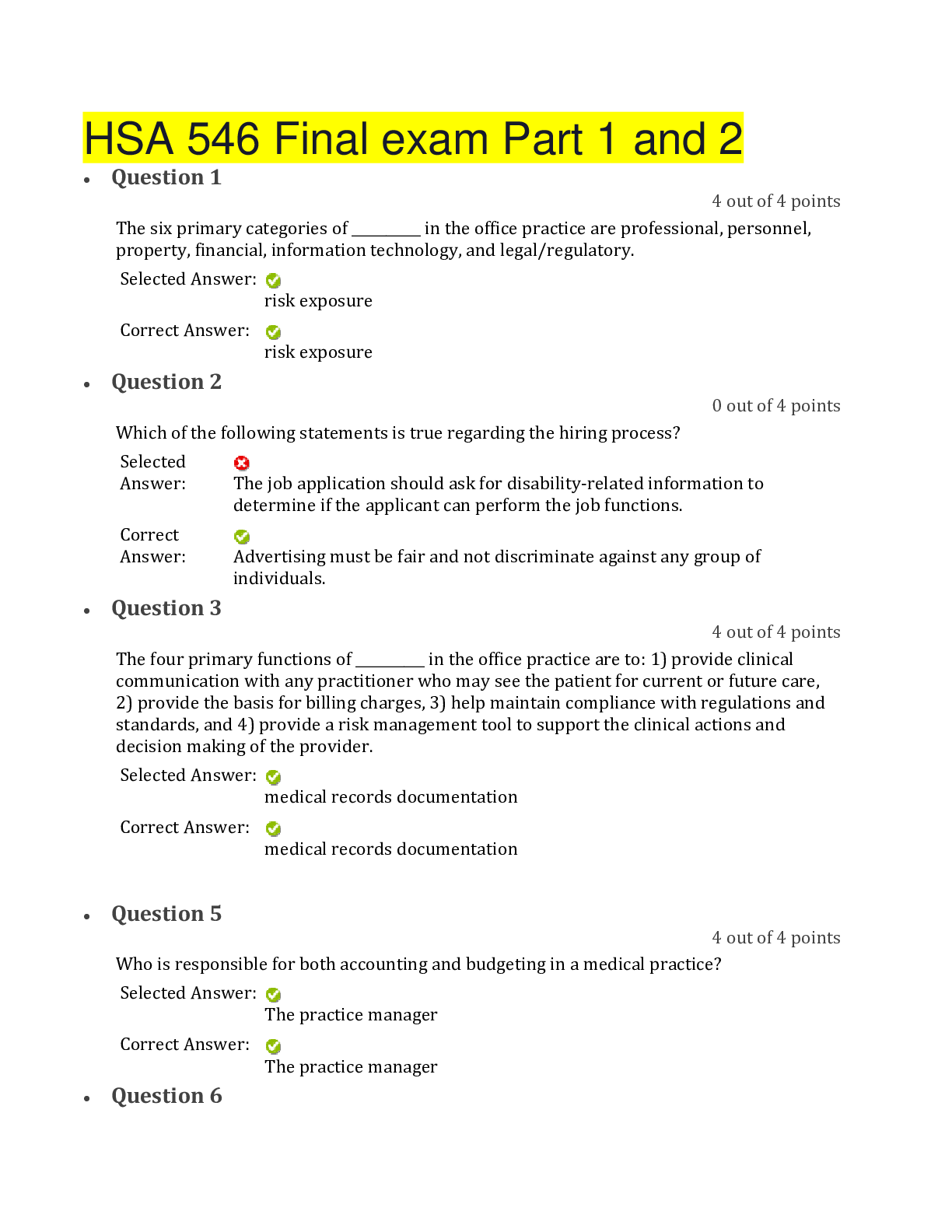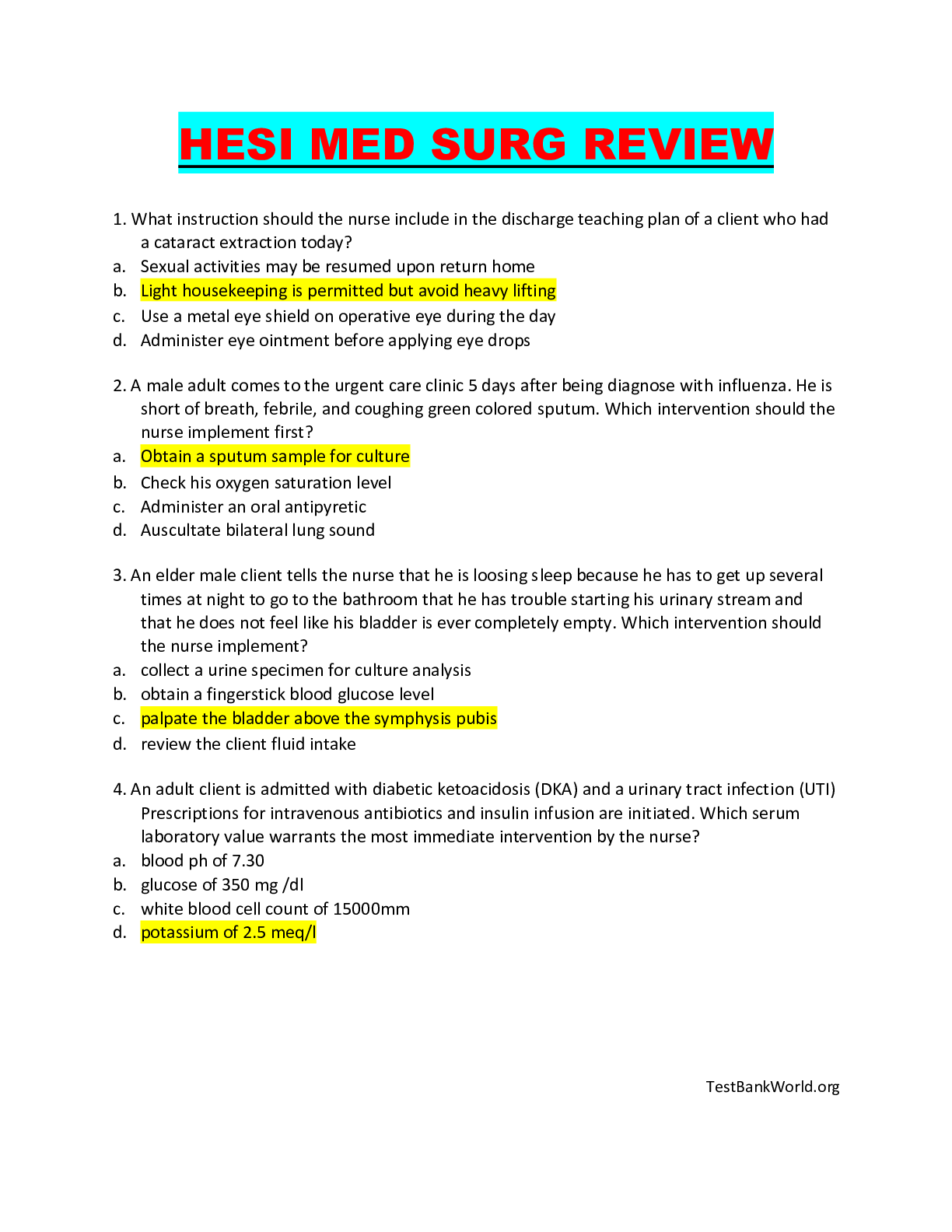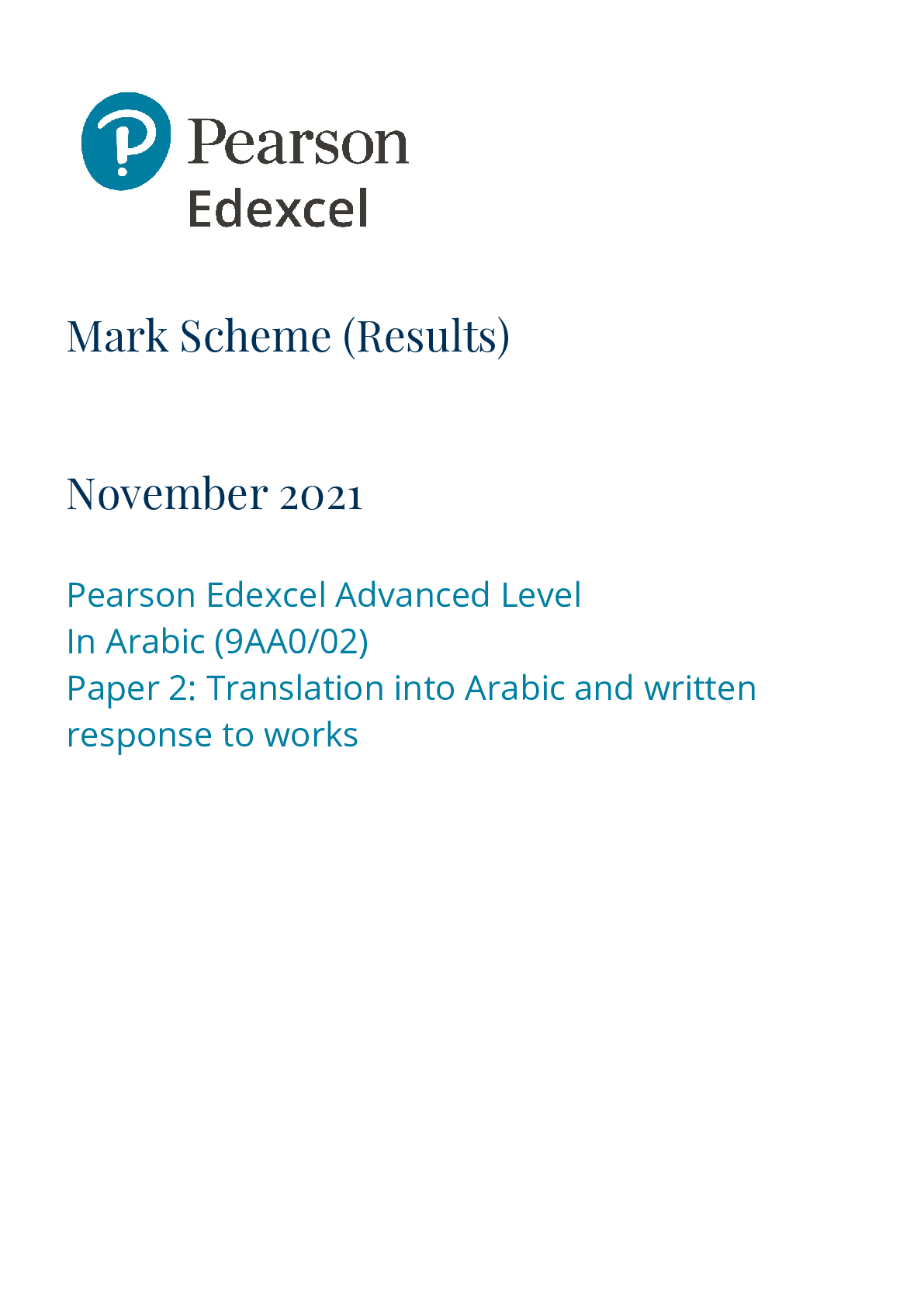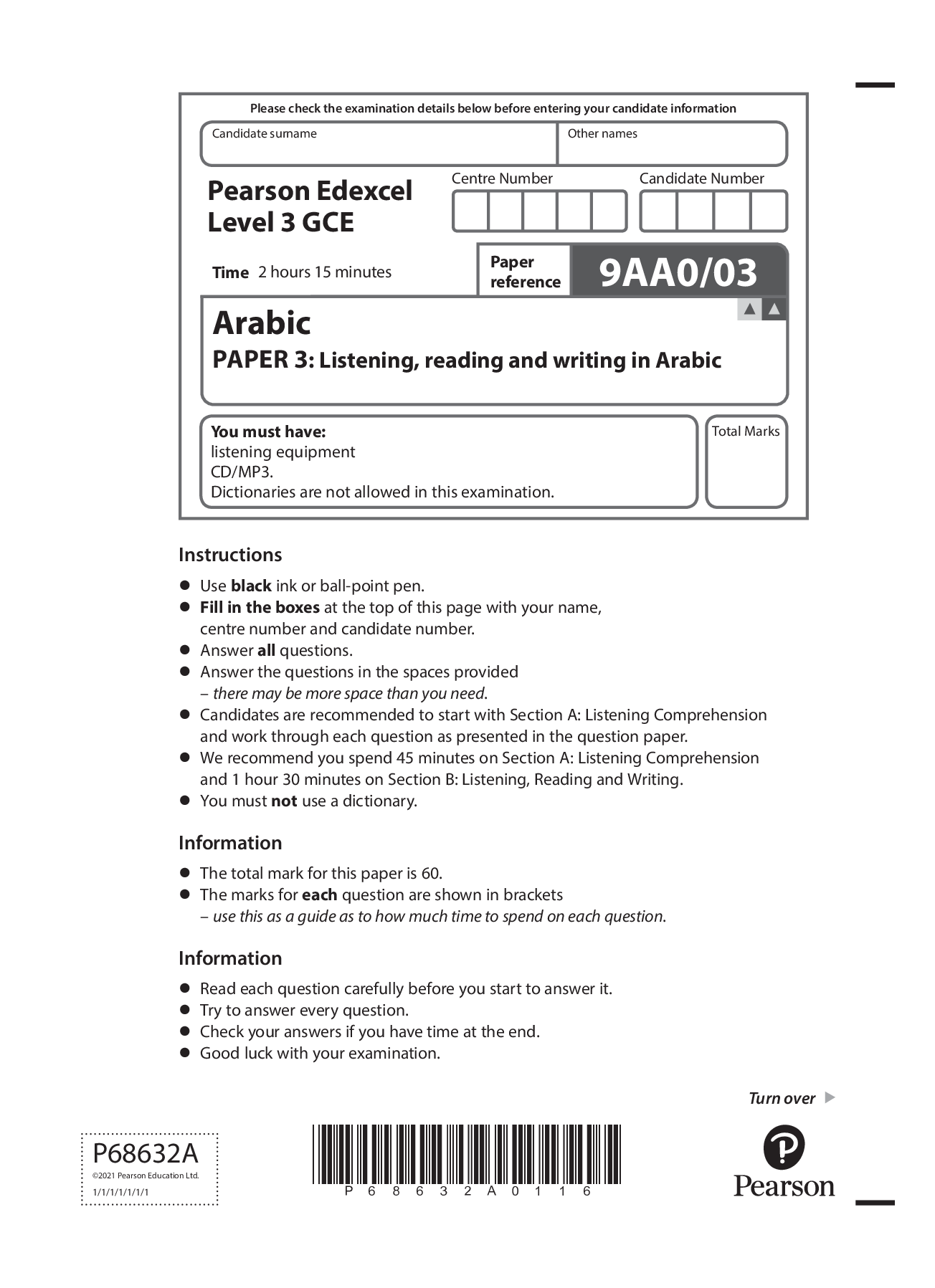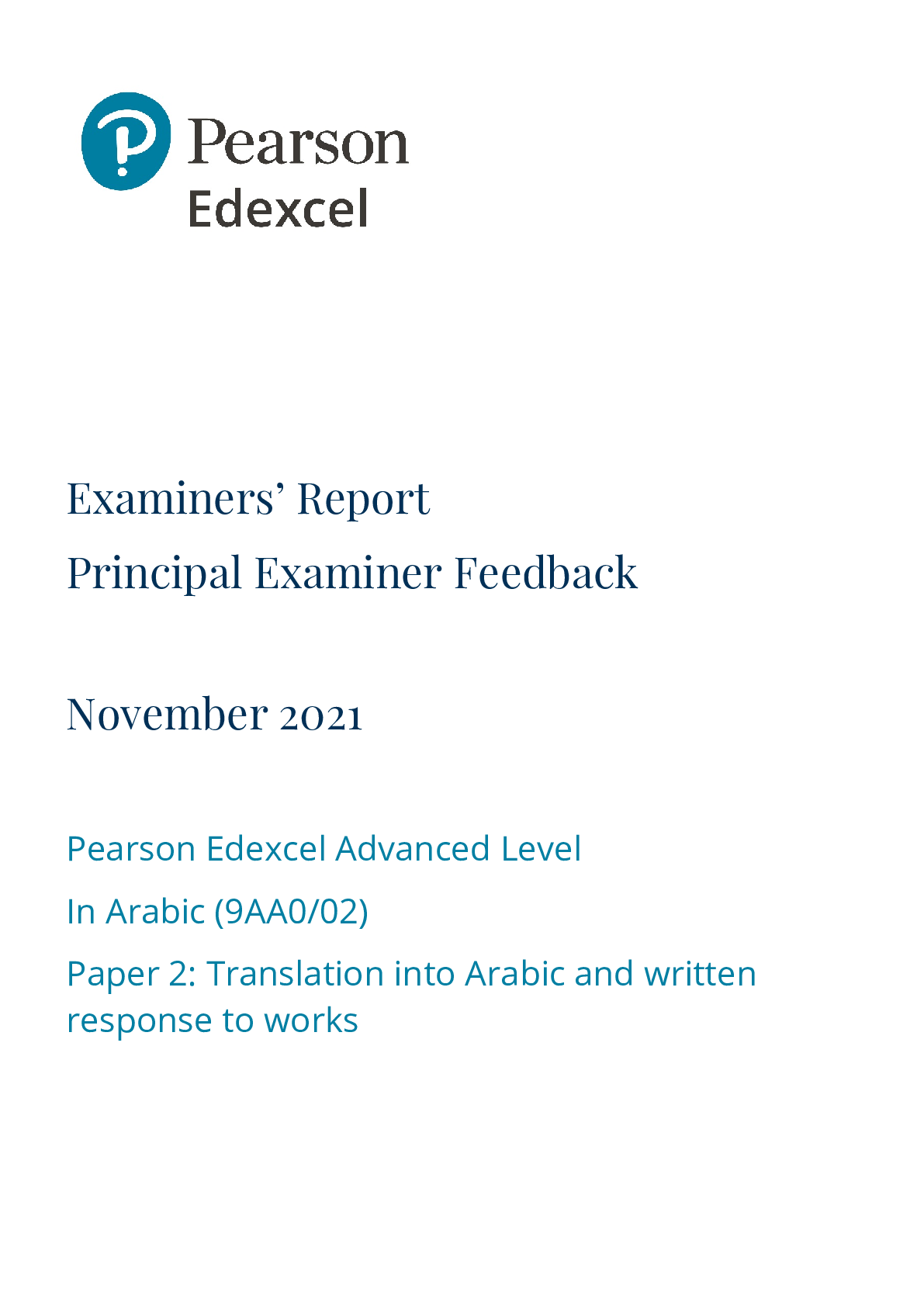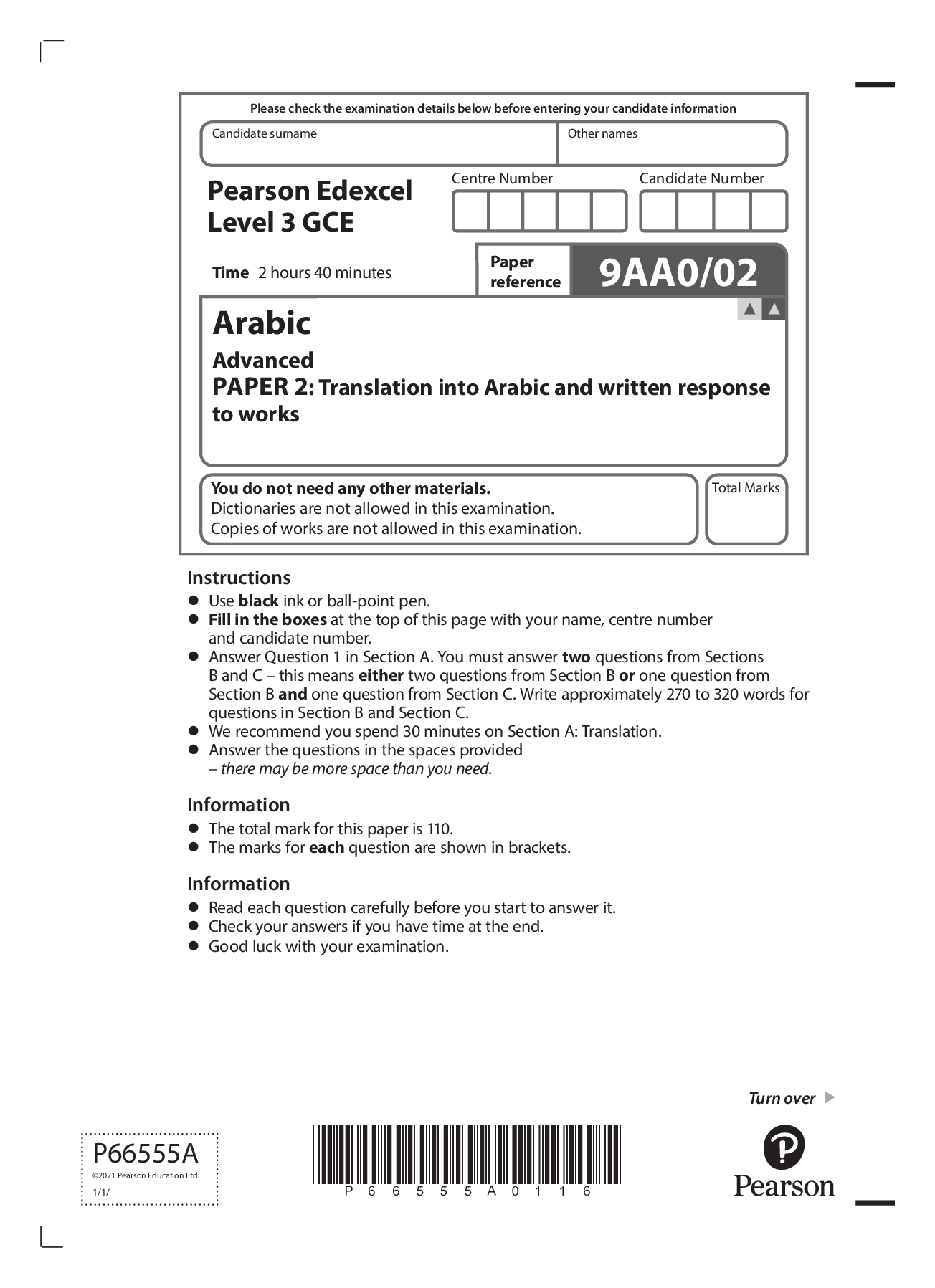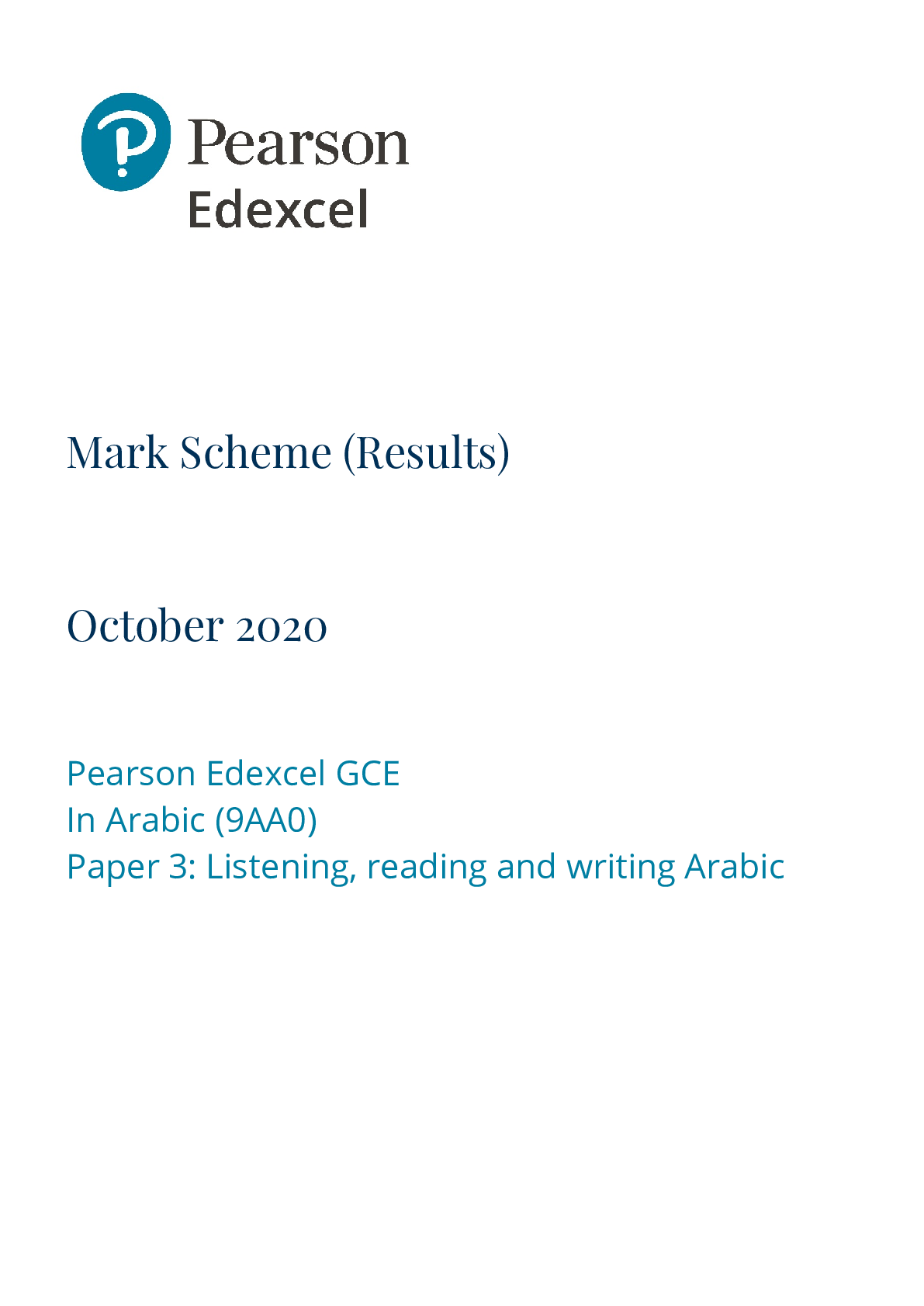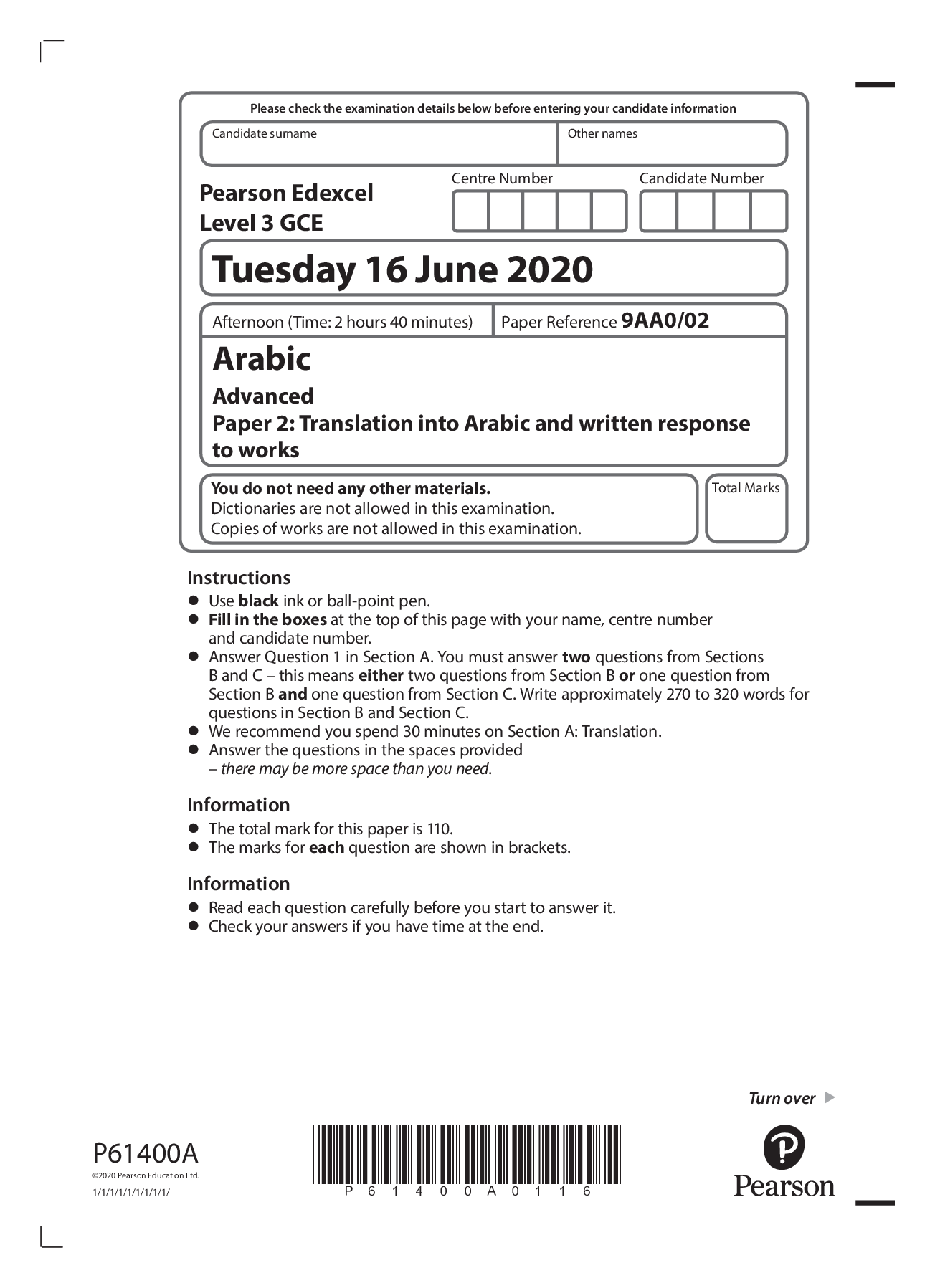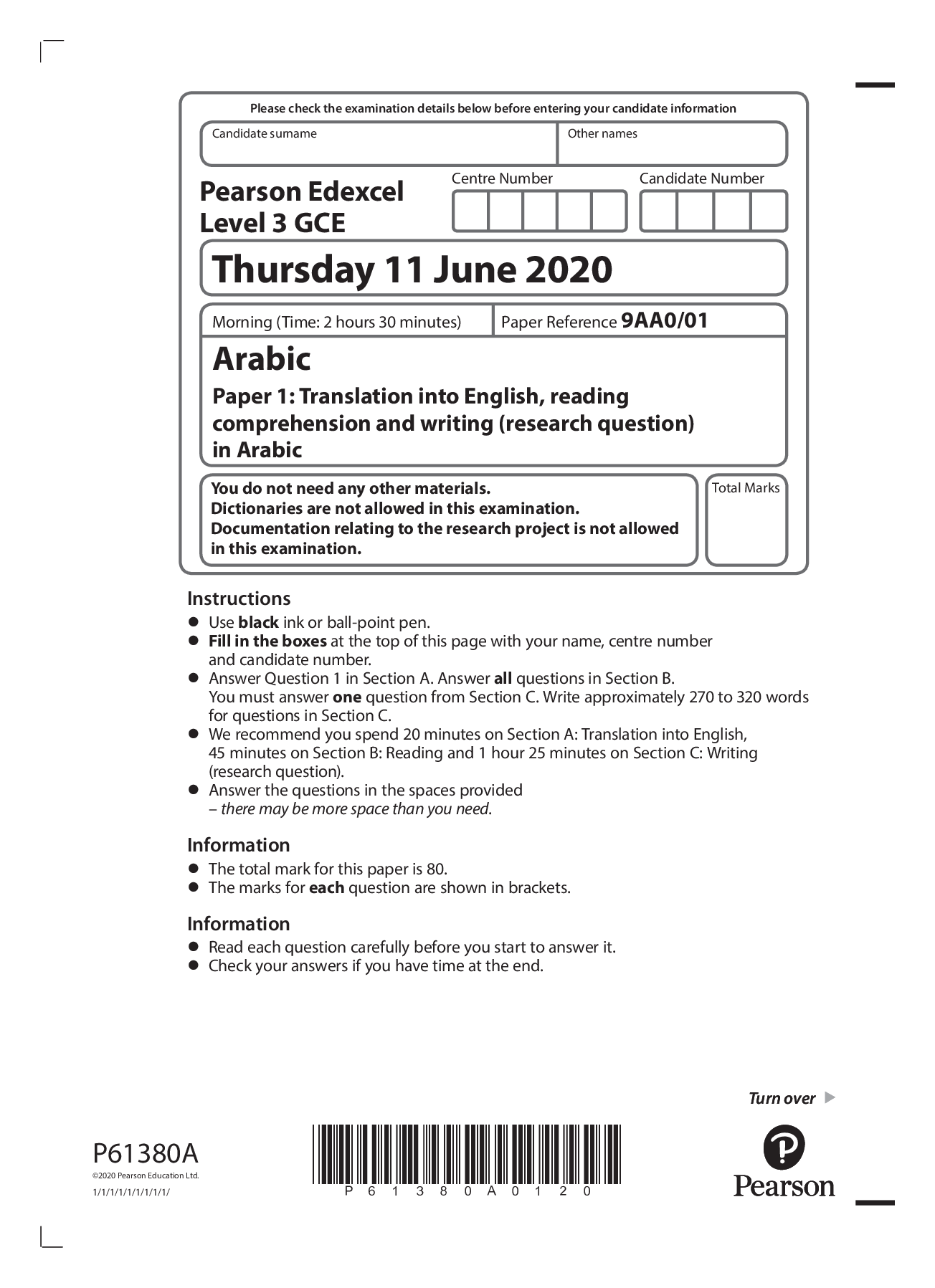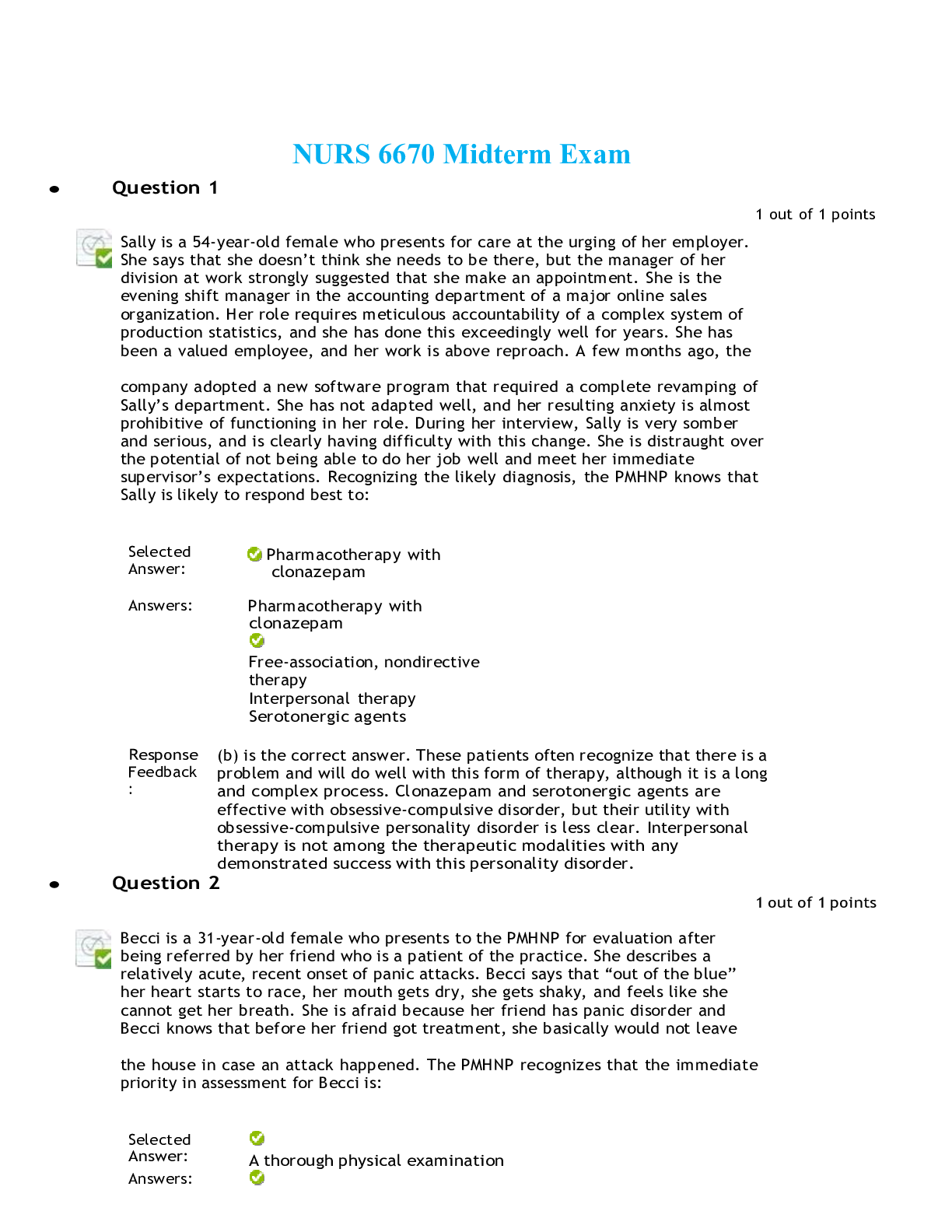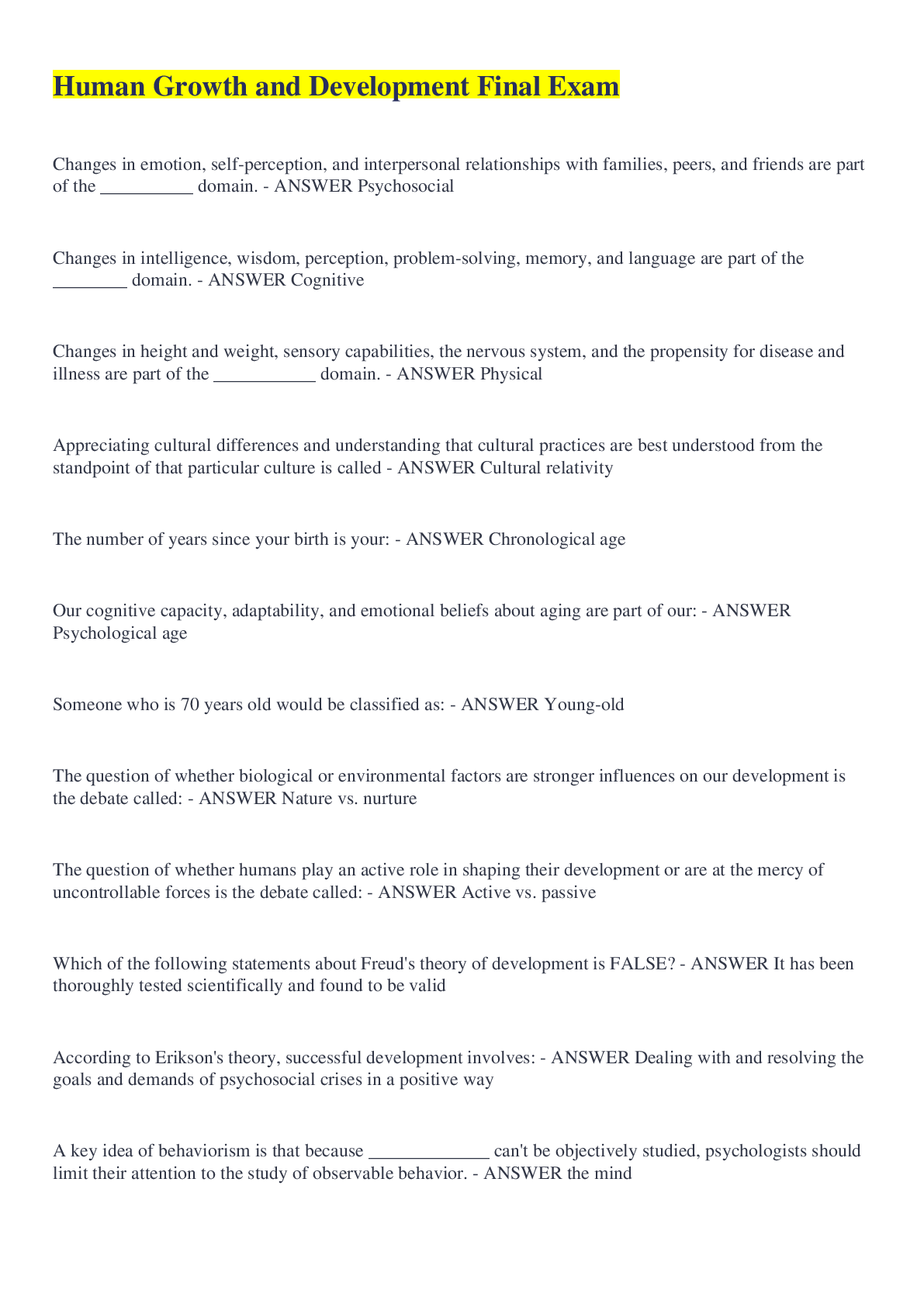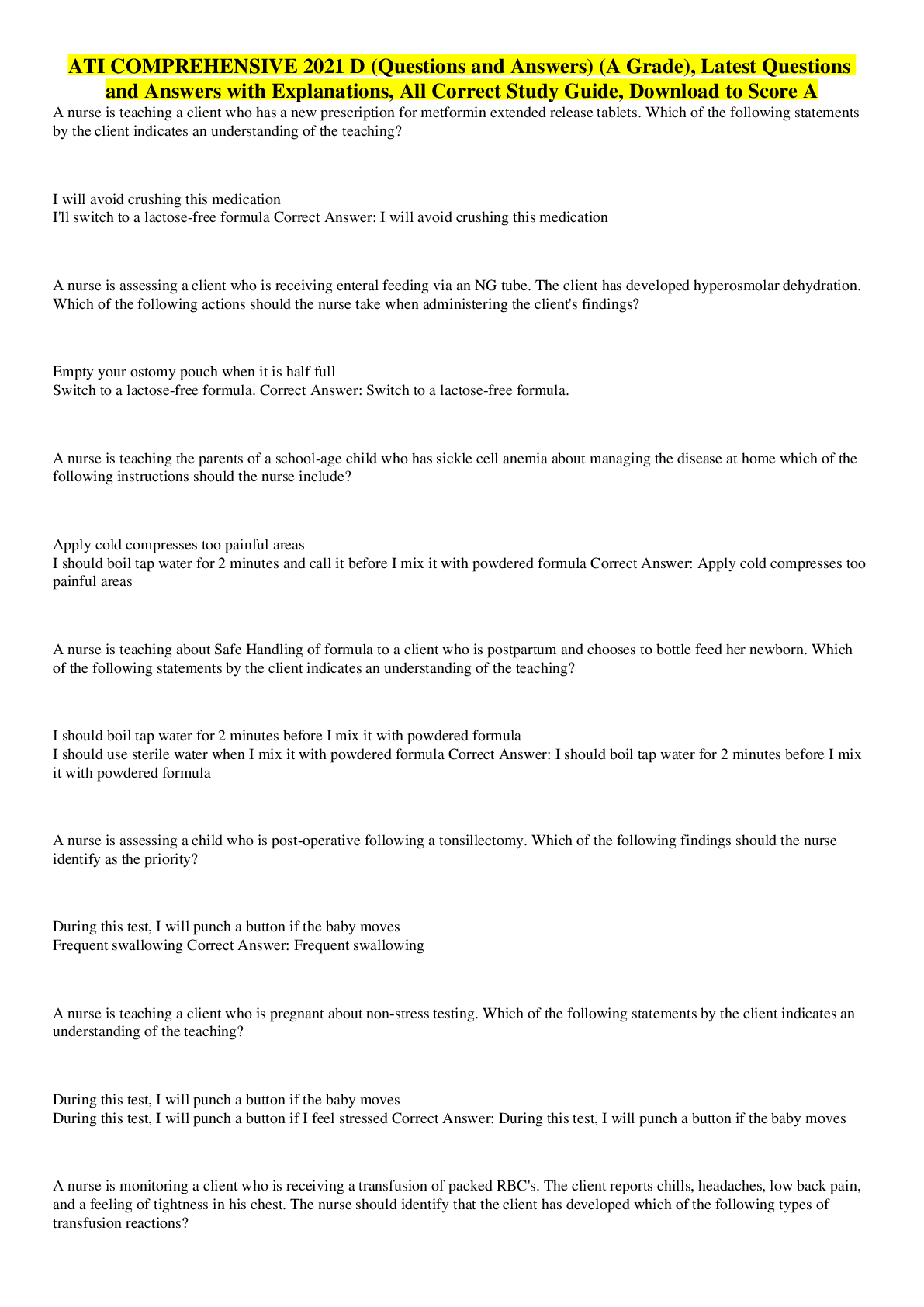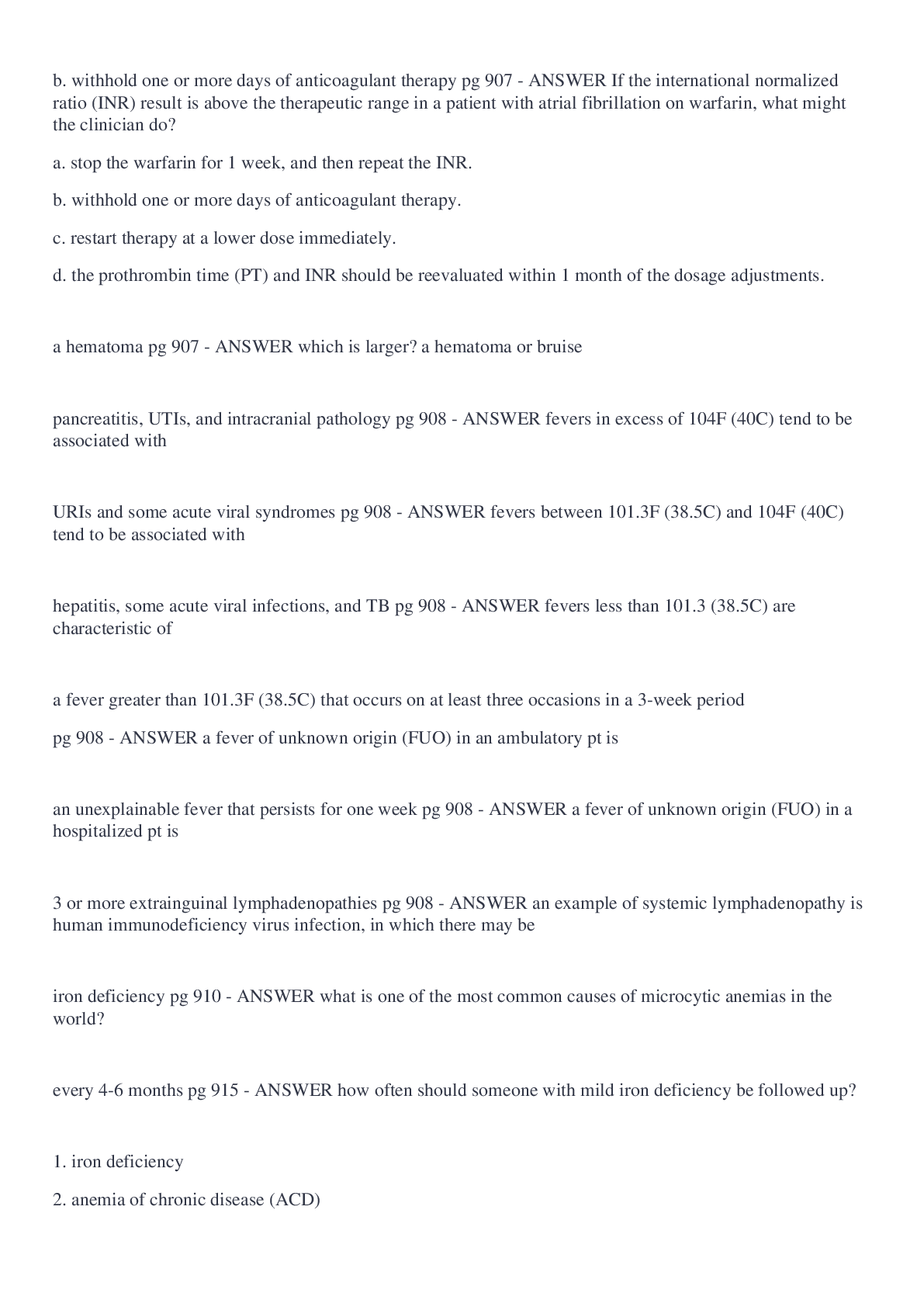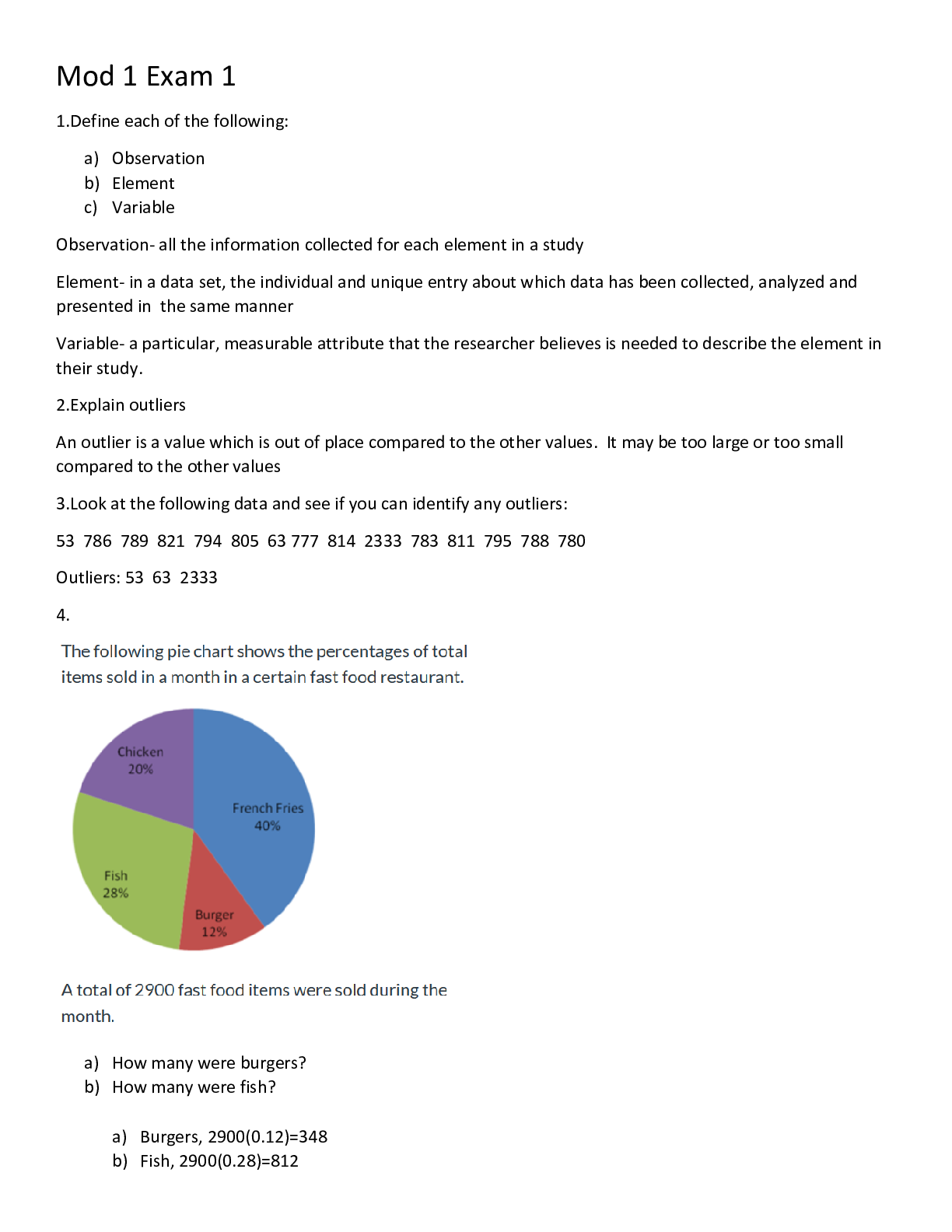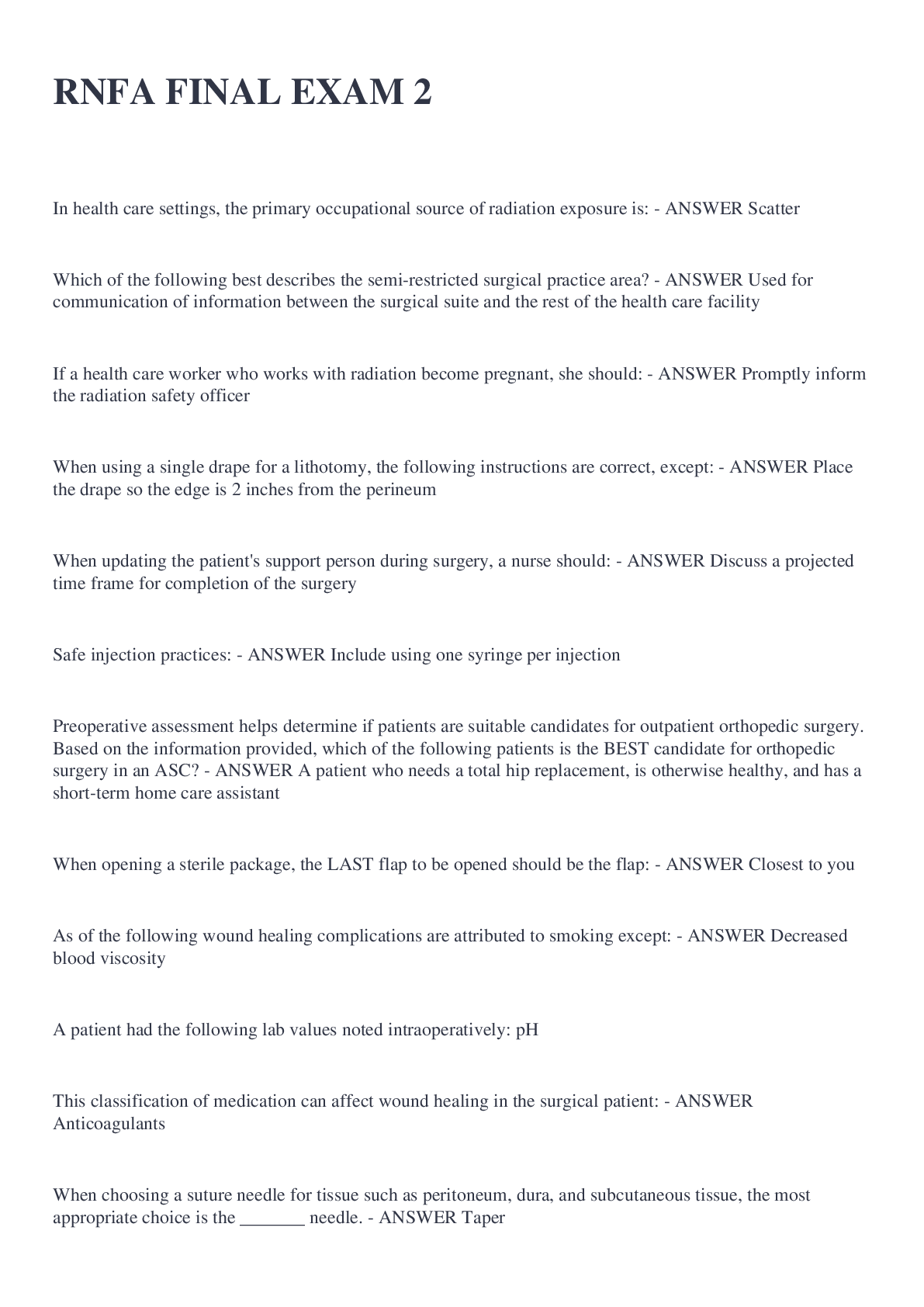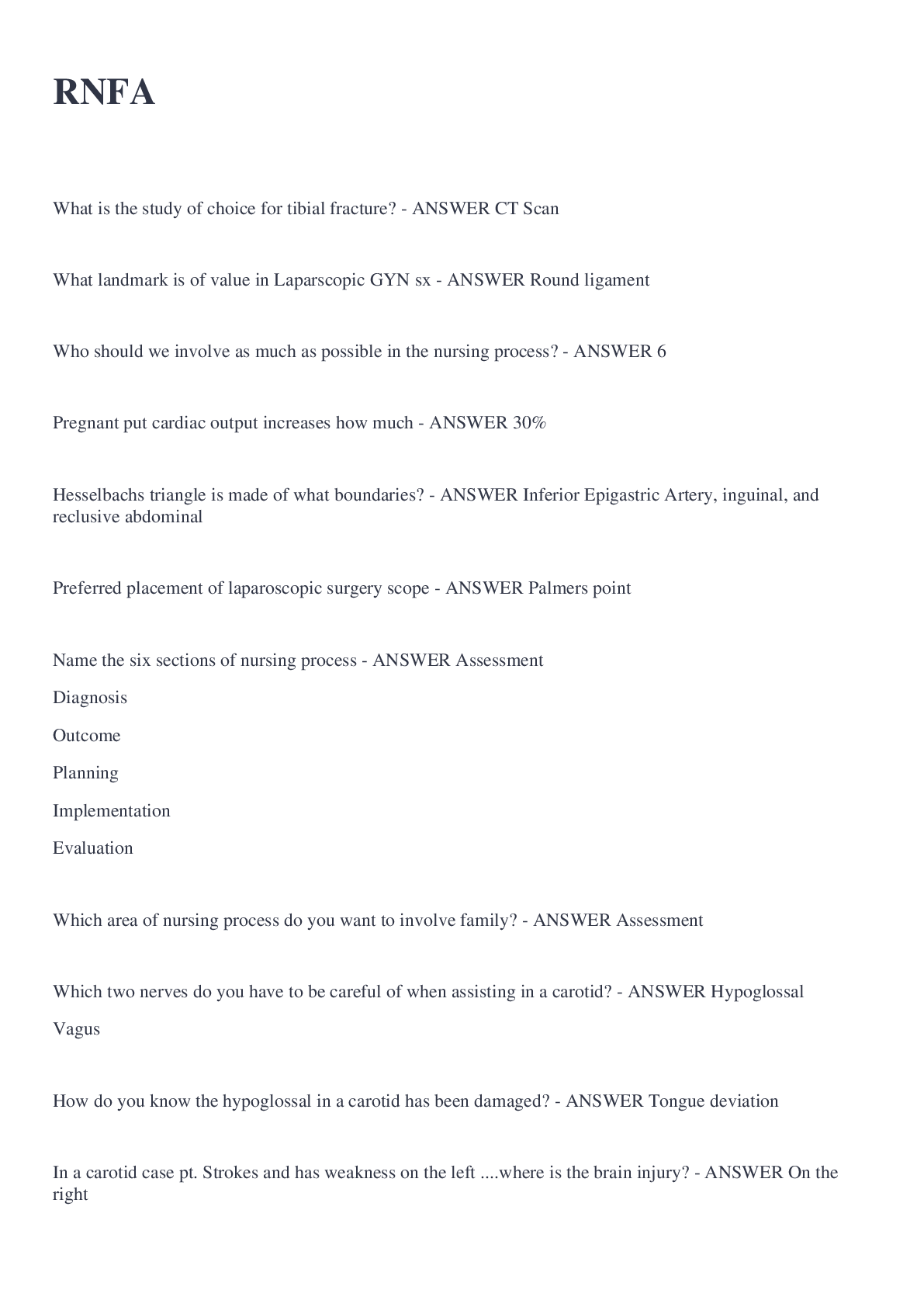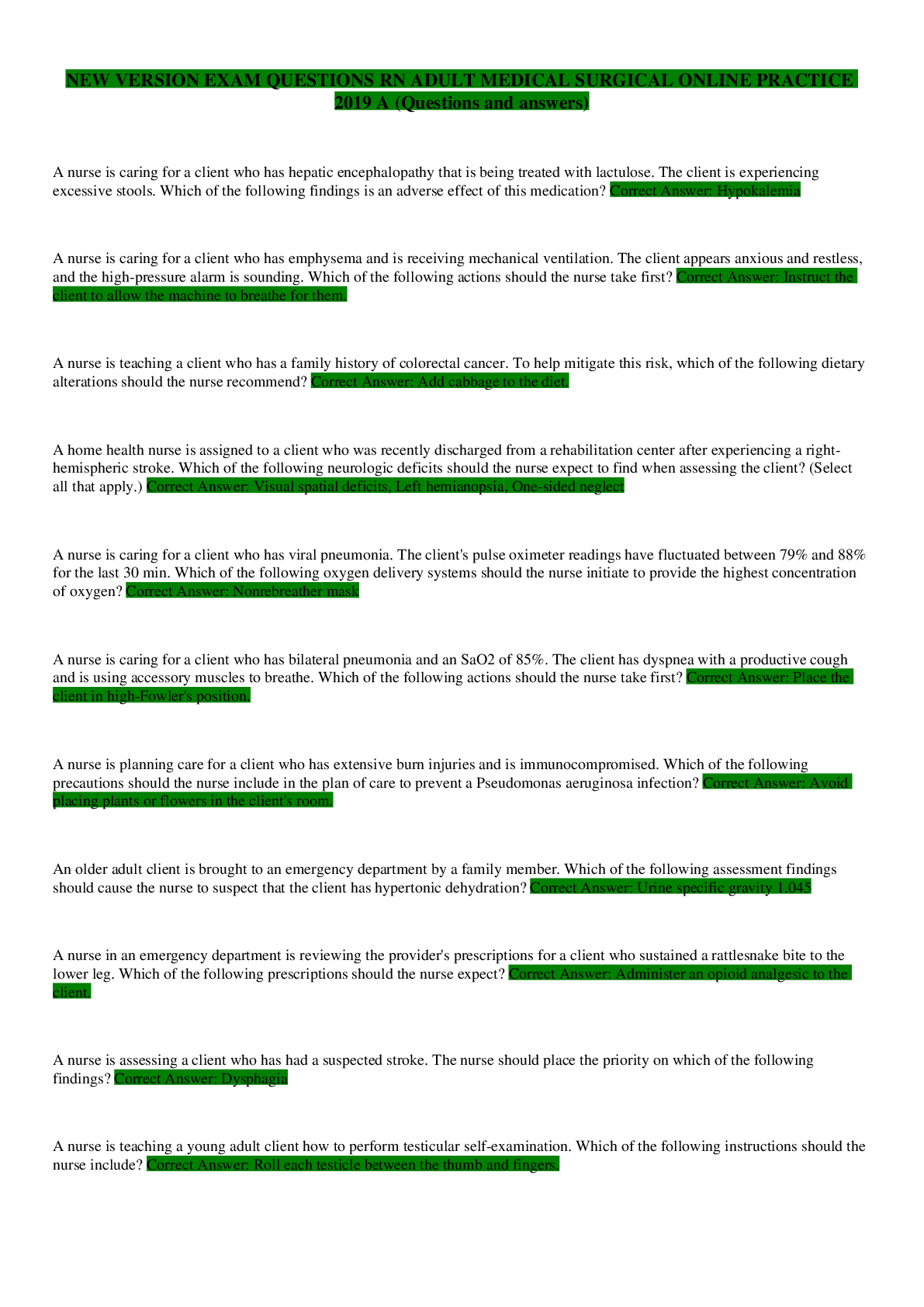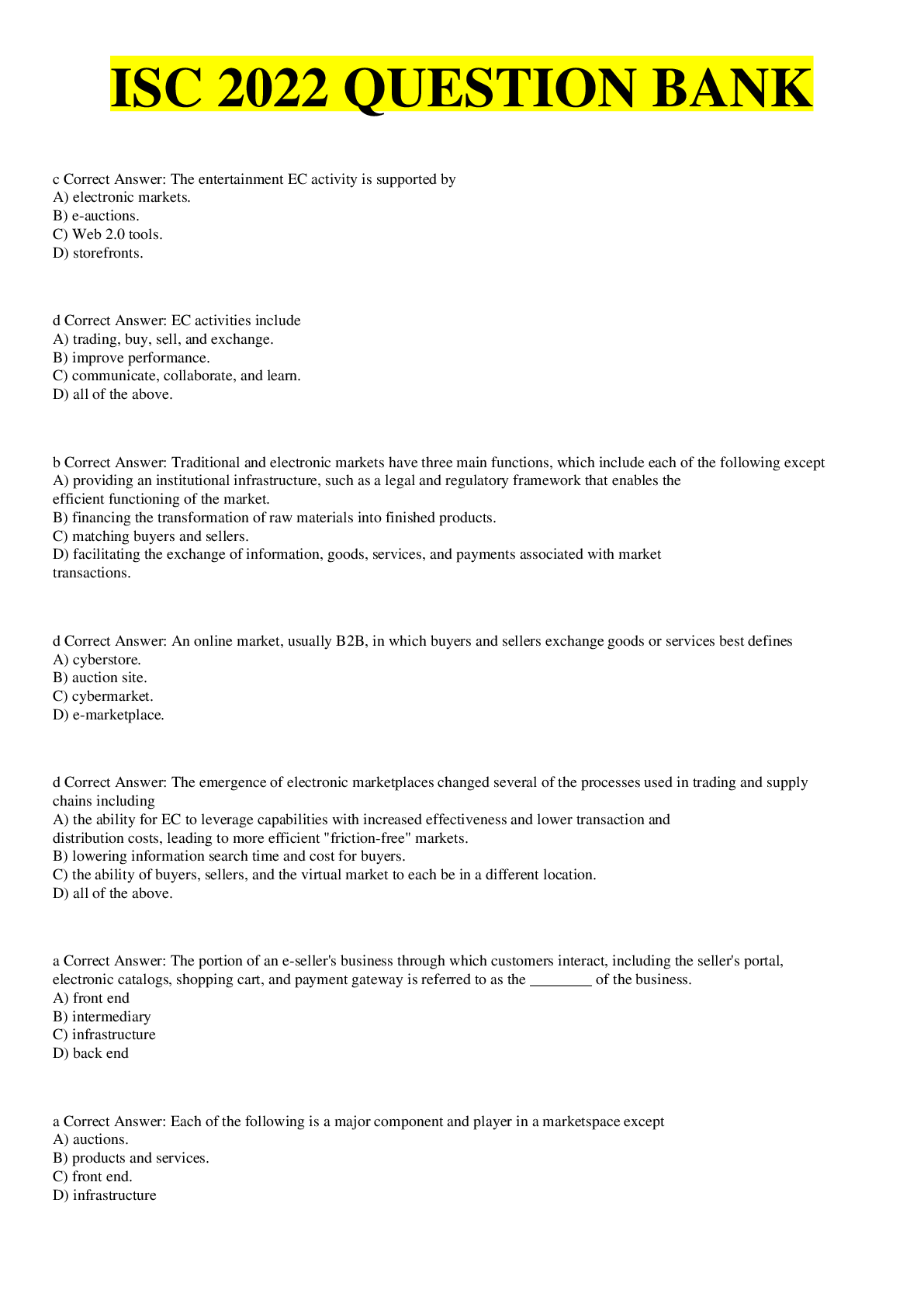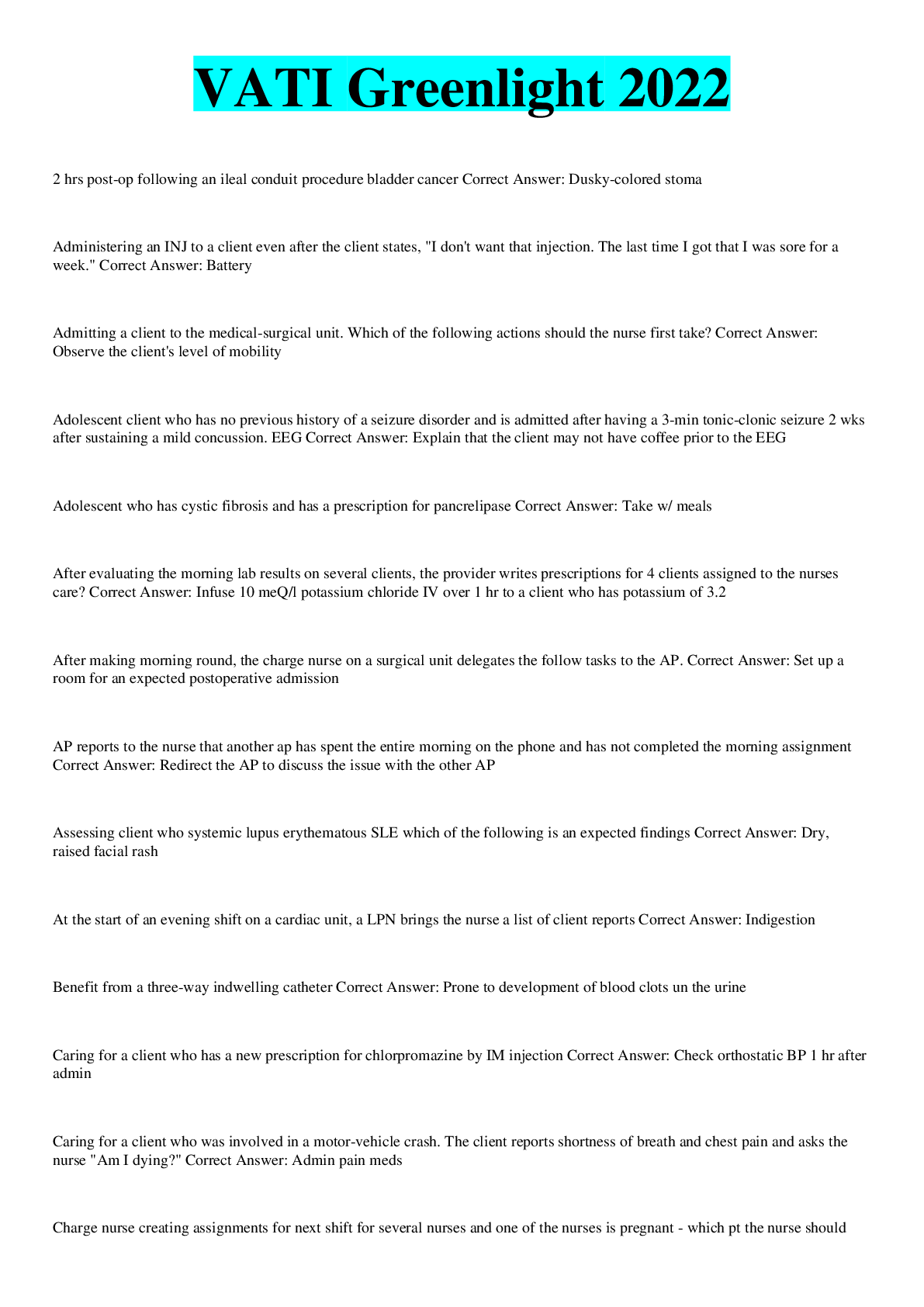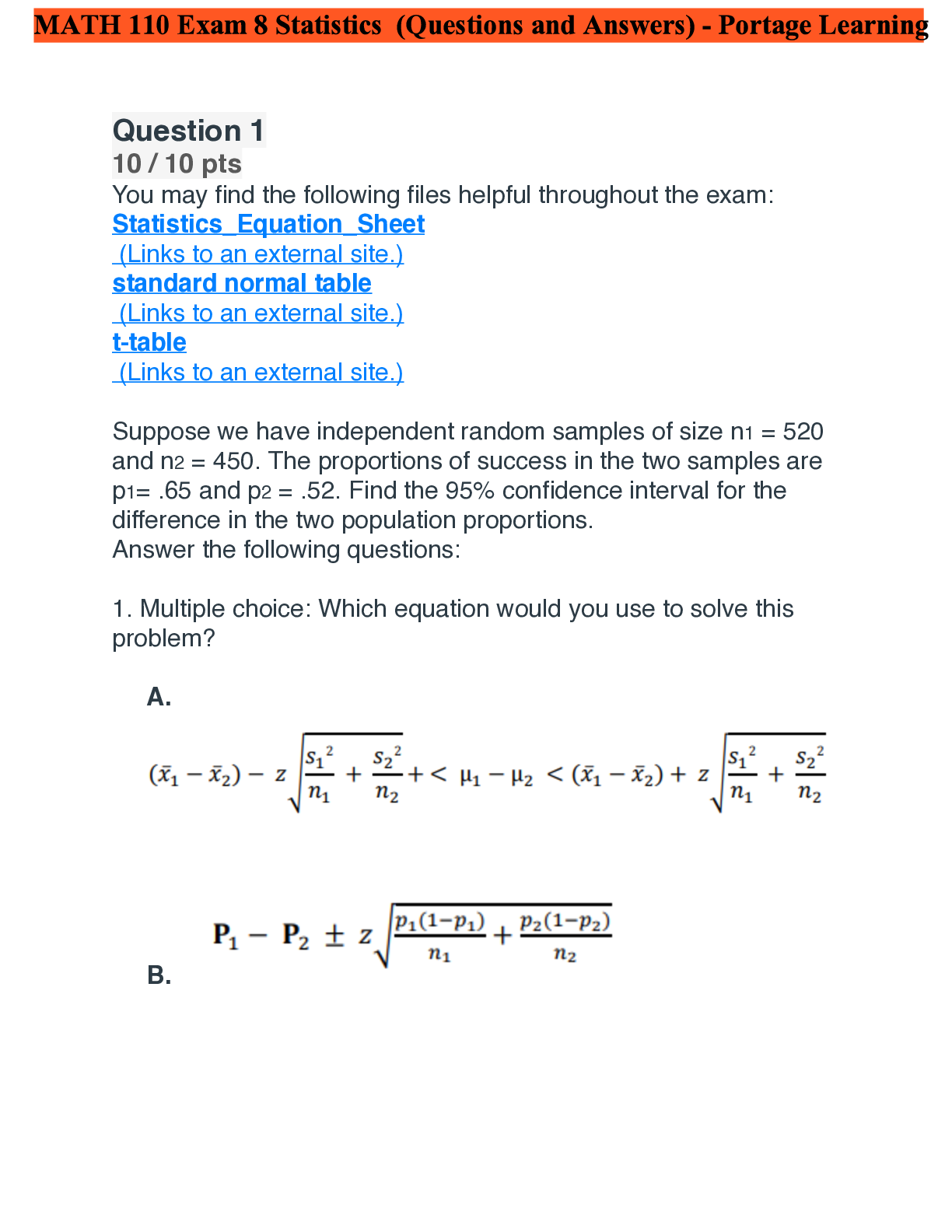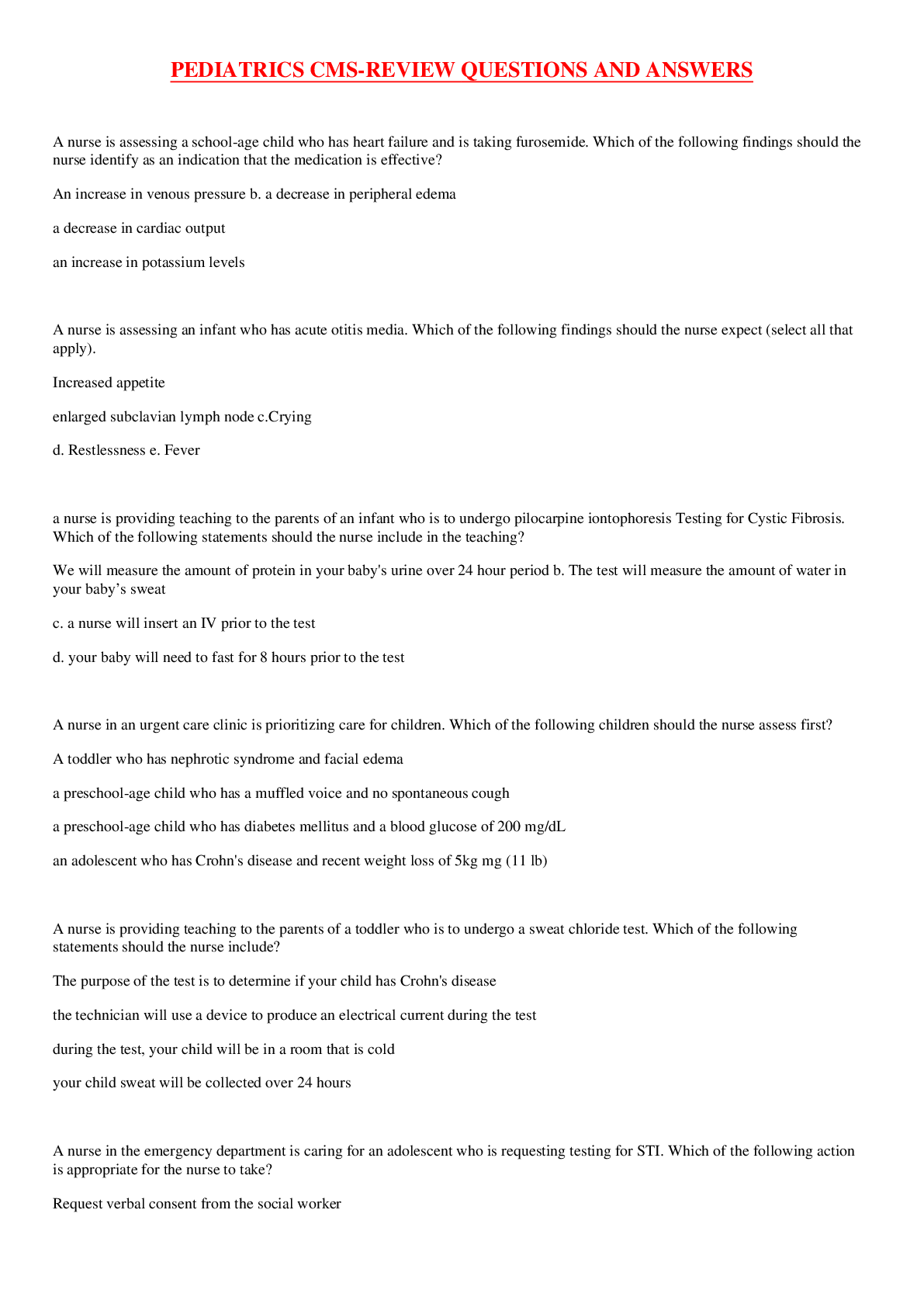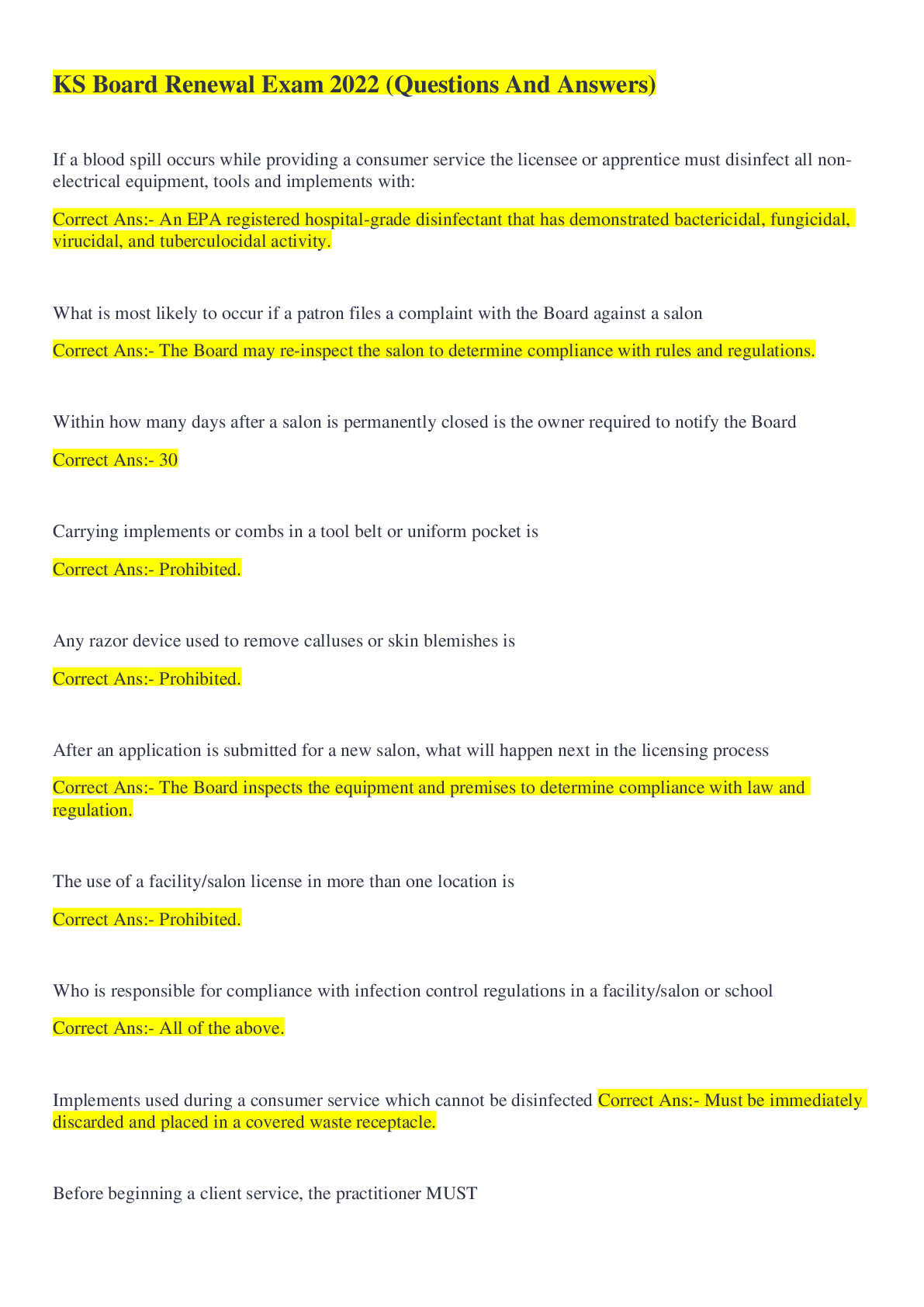MN 568 Unit 4 Exam (Questions and Answers)
Document Content and Description Below
MN 568 Unit 4 Exam (Questions and Answers) MN 568 Unit 4 Exam Random Section 1 Question 1 2 / 2 points Which of the following is associated with celiac disease (celiac sprue)? Question optio... ns: a) Malabsorption b) Constipation c) Rectal bleeding d) Esophageal ulceration Question 2 2 / 2 points The nurse practitioner (NP) suspects a patient has a peptic ulcer. Which of the following items on the history would lead the NP to this conclusion? Question options: a) Use of NSAIDs b) Cigarette smoker c) Ethanol consumption d) All of the above Question 3 2 / 2 points Which of the following dietary instructions should be given to a patient with GERD? Question options: a) Eliminate coffee. b) Drink peppermint tea to relieve stomach distress. c) Recline and rest after meals. d) Limit the amount of antacids. Question 4 2 / 2 points Which high-density lipoprotein (HDL) level is considered cardioprotective? Question options: a) Greater than 30 b) Greater than 40 c) Greater than 50 d) Greater than 60 Question 5 2 / 2 points A patient is seen with complaints of diarrhea. Which of the following should be included in the patient’s differential diagnosis? Question options: a) Gastroenteritis b) Inflammatory bowel disease c) Lactase deficiency d) All of the above Question 6 2 / 2 points There are four stages of heart failure, classified as A to D, that describe the evolution and progression of disease. In which stage are patients hospitalized or treated with specialized interventions or hospice care for refractory symptoms of heart failure despite medical therapy? Question options: a) Stage A b) Stage B c) Stage C d) Stage D Question 7 2 / 2 points A 28-year-old patient is seen in the clinic with colicky abdominal pain particular with meals. She has frequent constipation, flatulence, and abdominal distension. Which of the data make a diagnosis of diverticulitis unlikely? Question options: a) Her age b) Frequent constipation c) Flatulence d) Colicky abdominal pain Question 8 0 / 2 points Which ECG change is typical of cardiac ischemia? Question options: a) T-wave inversion b) ST-segment elevation c) Significant Q wave d) U-wave Question 9 2 / 2 points What percentage of patients with angina pectoris will have simultaneous dyspnea, caused by transient increase in pulmonary venous pressures that accompany ventricular stiffening during an episode of myocardial ischemia? Question options: a) About 20% b) About 30% c) About 50% d) Almost all Question 10 0 / 2 points A patient is diagnosed with GERD, and his endoscopic report reveals the presence of Barrett’s epithelium. Which of the following should the PCP include in the explanation of the pathology report? Question options: a) This is a premalignant tissue. b) This tissue is resistant to gastric acid. c) This tissue supports healing of the esophagus. d) All of the above Question 11 0 / 2 points A blood pressure (BP) of 150/90 is considered: Question options: a) Stage 2 hypertension b) Hypertensive c) Normal in healthy older adults d) Acceptable if the patient has DM Question 12 0 / 2 points A 21-year-old student presents with complaints of fatigue, headache, anorexia, and a runny nose, all of which began about 2 weeks ago. She started taking vitamins and over-the-counter cold preparations but feels worse. The smell of food makes her nauseated. Her boyfriend had mononucleosis about a month ago, and she wonders if she might have it also. Examination reveals cervical adenopathy and an enlarged liver and spleen. Which of the following labs would be most helpful in the differential diagnosis at this point? Question options: a) Stool culture b) Liver enzymes c) Antihepatitis D virus d) Thyroid-stimulating hormone test Question 13 0 / 2 points A 29-year-old Englishman is seen in the office with complaints of pain in his chest and belly. He has been suffering the pain for 2 weeks and gets temporary relief from Alka-Seltzer®. The burning pain wakes him at night and radiates up to his chest. Which factor favors a diagnosis of gastric ulcer? Question options: a) His gender b) His age c) His use of Alka-Seltzer d) His ethnic origin Question 14 2 / 2 points In the CHADS2 Index for the stroke risk score for AF, the ‘A’ stands for: Question options: a) Anticoagulation b) Autoimmune disease c) Age d) Antihypertension Question 15 2 / 2 points Which test has long been considered the gold standard for a diagnosis of venous thromboembolism? Question options: a) Ultrasound b) Magnetic resonance imaging (MRI) c) Ascending venogram d) D-dimer Question 16 2 / 2 points Statins are approved for which age group? Question options: a) Children over the age of 2 b) Children over the age of 6 c) Children over the age of 10 d) Only adolescents and adults Question 17 0 / 2 points George, age 64, has cardiovascular disease (CVD), a total cholesterol of 280 mg/dL, and a systolic BP of 158. He is being treated for hypertension. You are doing a Framingham Risk Assessment on him. Which assessment factor would give him the highest number of points on the scale? Question options: a) His age b) His cholesterol level c) His systolic BP d) The fact that he is on antihypertensive medication Question 18 2 / 2 points The American College of Cardiology/American Heart Association states which of the following regarding the use of non-statin lipid-lowering agents? Question options: a) Nicotinic acid derivatives are effective for lowering LDL and triglycerides (TGs). b) Bile acid sequestrates increase HDL. c) Cholesterol absorption inhibitors decrease LDL. d) There is no sufficient evidence to use non-statin lipid-drugs. Question 19 2 / 2 points A 35-year-old female patient is seen in the clinic complaining of abdominal pain. Which of the following should be included in the history and physical examination? Question options: a) Digital rectal exam b) Pelvic exam c) Sexual history d) All of the above Question 20 2 / 2 points When teaching post MI patients about their NTG tablets, the clinician should stress that the tablets should remain in the light-resistant bottle in which they are packaged and should not be put in another pill box or remain in areas that are or could become warm and humid. Once opened, the bottle must be dated and discarded after how many months? Question options: a) 1 month b) 3 months c) 6 months d) As long as the tablets are kept in this special bottle, they will last forever. Question 21 2 / 2 points A patient is diagnosed with giardia after a backpacking trip in the mountains. Which of the following would be an appropriate treatment? Question options: a) Vancomycin b) Penicillin c) Metronidazole d) Bactrim Question 22 2 / 2 points Which of the following is abundant in the heart and rapidly rises in the bloodstream in the presence of heart failure, making it a good diagnostic test? Question options: a) B-type natriuretic peptide b) C-reactive protein c) Serum albumin d) Erythrocyte sedimentation rate Question 23 0 / 2 points In which type of arterioventricular (AV) block does the pulse rate (PR) interval lengthen until a beat is dropped? Question options: a) First-degree AV block b) Second-degree Mobitz I AV block c) Second-degree Mobitz II AV block d) Third-degree AV block Question 24 2 / 2 points Nitroglycerine (NTG) is given for a patient having ischemic chest pain. One tablet or one spray should be used under the tongue every 5 minutes for three doses. What should be done if the pain has not been relieved after three doses? Question options: a) 911 should be called, and the patient should be transported immediately to the emergency department. b) One more dose of NTG may be tried. c) The person should be given two aspirin to chew. d) A portable defibrillator should be located to ascertain the cardiac rhythm. Question 25 0 / 2 points For the best therapeutic effect after a myocardial infarction (MI), thrombolytics should be administered within the first 3 hours (ideally 30 minutes) of symptom onset. Studies have shown, however, that thrombolytic therapy can be of benefit up to how many hours after the initial presentation of MI symptoms? Question options: a) 6 hours b) 8 hours c) 10 hours d) 12 hours Question 26 2 / 2 points A 25-year-old accountant is seen in the clinic complaining of crampy abdominal pain after meals. She is often constipated and takes laxatives, which are followed by a couple of days of diarrhea. She temporarily feels better after a bowel movement. She states she is embarrassed by flatulence and has abdominal distension. She has had no weight loss or blood in her stool. This problem has gone on for about 6 months. What should the next step be? Question options: a) Obtain a complete history. b) Order a barium enema. c) Schedule a Bernstein’s test. d) Prescribe a trial of antispasmodics. Question 27 0 / 2 points A patient is seen in the office with complaints of six to seven liquid bowel movements per day. Which of the following assessment findings would lead the NP to a diagnosis of inflammatory bowel disease? Question options: a) Intermittent constipation with periods of diarrhea b) Wakens at night with diarrhea c) History of international travel d) All of the above Question 28 2 / 2 points Which type of angina do you suspect in Harvey, who complains of chest pain that occurs during sleep and most often in the early morning hours? Question options: a) Stable angina b) Unstable angina c) Variant (Prinzmetal’s angina) d) Probably not angina but hiatal hernia Question 29 0 / 2 points A 22-year-old is seen complaining of vague belly pain. This type of pain is seen at what point in appendicitis? Question options: a) Very early b) 3 to 4 hours after perforation c) Late in inflammation d) Appendicitis never presents with vague pain. Question 30 0 / 2 points Which group would most benefit from statins? Question options: a) Those with a low density lipoprotein-cholesterol greater than 100 mg/dL b) Individuals with clinical arteriosclerotic cardiovascular disease c) Individuals with a 10-year risk greater than 10% d) Individuals of all ages with diabetes mellitus (DM) Question 31 0 / 2 points A 46-year-old female patient is seen in the clinic with abdominal pain. Which of the following tests is essential for this patient? Question options: a) CBC with differential b) Urine human chorionic gonadotropin c) Barium enema d) Computed tomography of the abdomen Question 32 2 / 2 points The patient with GERD should be instructed to eliminate which of these activities? Question options: a) Swimming b) Weight lifting c) Golfing d) Walking Question 33 2 / 2 points A patient comes to the office complaining of constipation. The patient lists all of the following medications. Which drug could be responsible for the constipation? Question options: a) Multivitamin b) Magnesium hydroxide c) Pepto-Bismol® d) Ibuprofen Question 34 0 / 2 points Mr. J. K., 38 years old, is 5 feet 8 inches tall and weighs 189 pounds. He reports that he has had intermittent heartburn for several months and takes Tums® with temporary relief. He has been waking during the night with a burning sensation in his chest. Which additional information would lead you to believe that gastroesophageal reflux disease (GERD) is the cause of his pain? Question options: a) The pain seems better when he smokes to relieve his nerves. b) Coffee and fried foods don’t bother him, c) He wakes at night coughing with a bad taste in his mouth. d) All of the above Question 35 0 / 2 points If chest pain can be alleviated with time, analgesics, and heat applications, what might the differential diagnosis be? Question options: a) Peptic ulcer b) Hiatal hernia c) Costochondritis d) Pericarditis Question 36 2 / 2 points A 45-year-old patient presents with a chief complaint of generalized abdominal pain. Her physical examination is remarkable for left lower quadrant tenderness. At this time, which of the following should be considered in the differential diagnosis? Question options: a) Endometriosis b) Colon cancer c) Diverticulitis d) All of the above Question 37 2 / 2 points A patient is seen with dark-colored urine, and the urine dipstick reveals a high level of bilirubin. Which of the following could be a cause of this problem? Question options: a) Increased breakdown of red blood cells b) Inadequate hepatocyte function c) Biliary obstruction d) All of the above Question 38 0 / 2 points A 28-year-old patient is seen with complaints of diarrhea. Which of the following responses to the history questions would help the primary care physician (PCP) establish the diagnosis of irritable bowel syndrome? Question options: a) Feels relief after a bowel movement b) Sometimes is constipated c) Does not defecate in the middle of the night d) All of the above Question 39 0 / 2 points On further questioning, the 21-year-old patient with complaints of fatigue, headache, anorexia, and a runny nose explains that she is sexually active only with her boyfriend, does not use injectable drugs, and works as an aide in a day-care center. Which of the following tests would be most helpful in confirming your diagnosis? Question options: a) Hepatitis A virus (HAV) IgM b) HAV IgG c) Anti-HAcAg d) Anti-HAsAg Question 40 0 / 2 points A patient has acute pancreatitis with seven of the diagnostic criteria from Ranson’s criteria. In order to plan care, the NP must understand that this criteria score has which of the following meanings? Question options: a) A high mortality rate b) An increased chance of recurrence c) A 7% chance of the disease becoming chronic d) All of the above Question 41 2 / 2 points Sandra has palpitations that occur with muscle twitching, paresthesia, and fatigue. What specific diagnostic test might help determine the cause? Question options: a) Serum calcium b) Electrocardiogram (ECG) c) Thyroid-stimulating hormone test d) Complete blood cell count Question 42 2 / 2 points What value on the ankle-brachial index diagnoses peripheral artery disease? Question options: a) Less than 0.25 b) Less than 0.50 c) Less than 0.90 d) Greater than 1 Question 43 2 / 2 points Which heart sound may be heard with poorly controlled hypertension, angina, and ischemic heart disease? Question options: a) A physiologic split S2 b) A fixed split S2 c) S3 d) S4 Question 44 2 / 2 points You are assessing Sigred for metabolic syndrome. Which of her parameters is indicative of this syndrome? Question options: a) Her waist is 36 inches. b) Her triglyceride level is 140 mg/dL. c) Her BP is 128/84. d) Her fasting blood sugar (BS) is 108 mg/dL. Question 45 0 / 2 points Which of the following statements about dabigatran is true? Question options: a) It is difficult to keep the patient in therapeutic range. b) Anticoagulation cannot be immediately reversed. c) It allows for the use of tPA if the patient has a stroke despite anticoagulation. d) None of the statements are true. Question 46 2 / 2 points Samuel is going to the dentist for some work and must take endocarditis prophylaxis because of his history of: Question options: a) Severe asthma b) A common valvular lesion c) Severe hypertension d) A prosthetic heart valve Question 47 2 / 2 points You just started Martha on HTN therapy. The Eighth Joint National Committee recommends that if her goal BP is not reached in what length of time, you should increase the initial drug or add a second drug to it? Question options: a) 1 month b) 3 months c) 6 months d) 1 year Question 48 2 / 2 points Which of the following is most effective in diagnosing appendicitis? Question options: a) History and physical b) Sedimentation rate c) Kidney, ureter, and bladder x-ray d) Complete blood count (CBC) with differentials Question 49 0 / 2 points Which pain characteristic is usually indicative of cardiac pathology? Question options: a) Fleeting b) Moving c) Diffuse d) Localized Question 50 0 / 2 points Jamie, age 55, has just started on a statin after having his liver function tests (LFTs) come back normal. He now asks you how often he has to have the LFTs repeated. What do you tell him? Question options: a) Initially in 6 weeks b) Every 3 months c) Every 6 months d) It’s no longer necessary for his statin regimen. ________________________________________ [Show More]
Last updated: 1 year ago
Preview 1 out of 19 pages
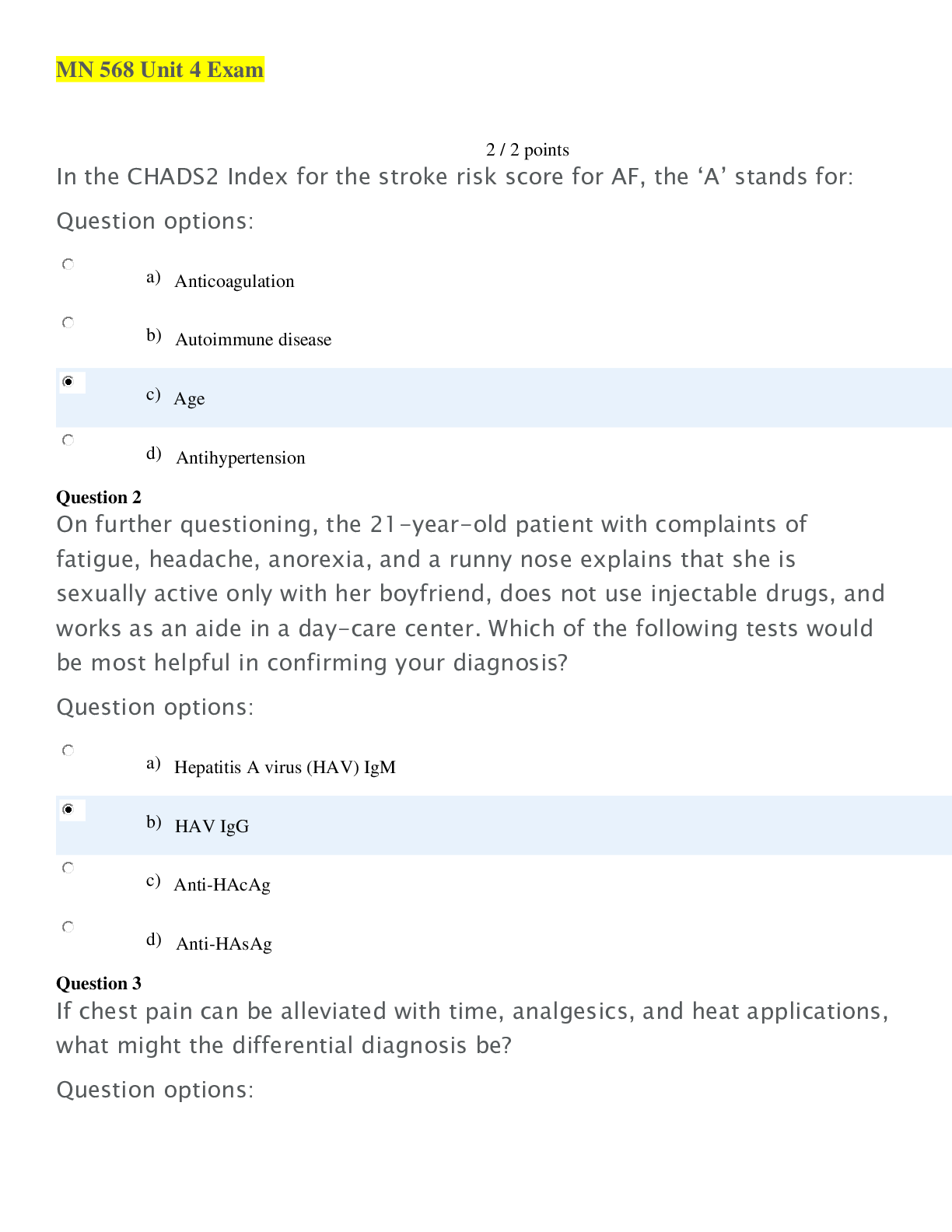
Also available in bundle (1)
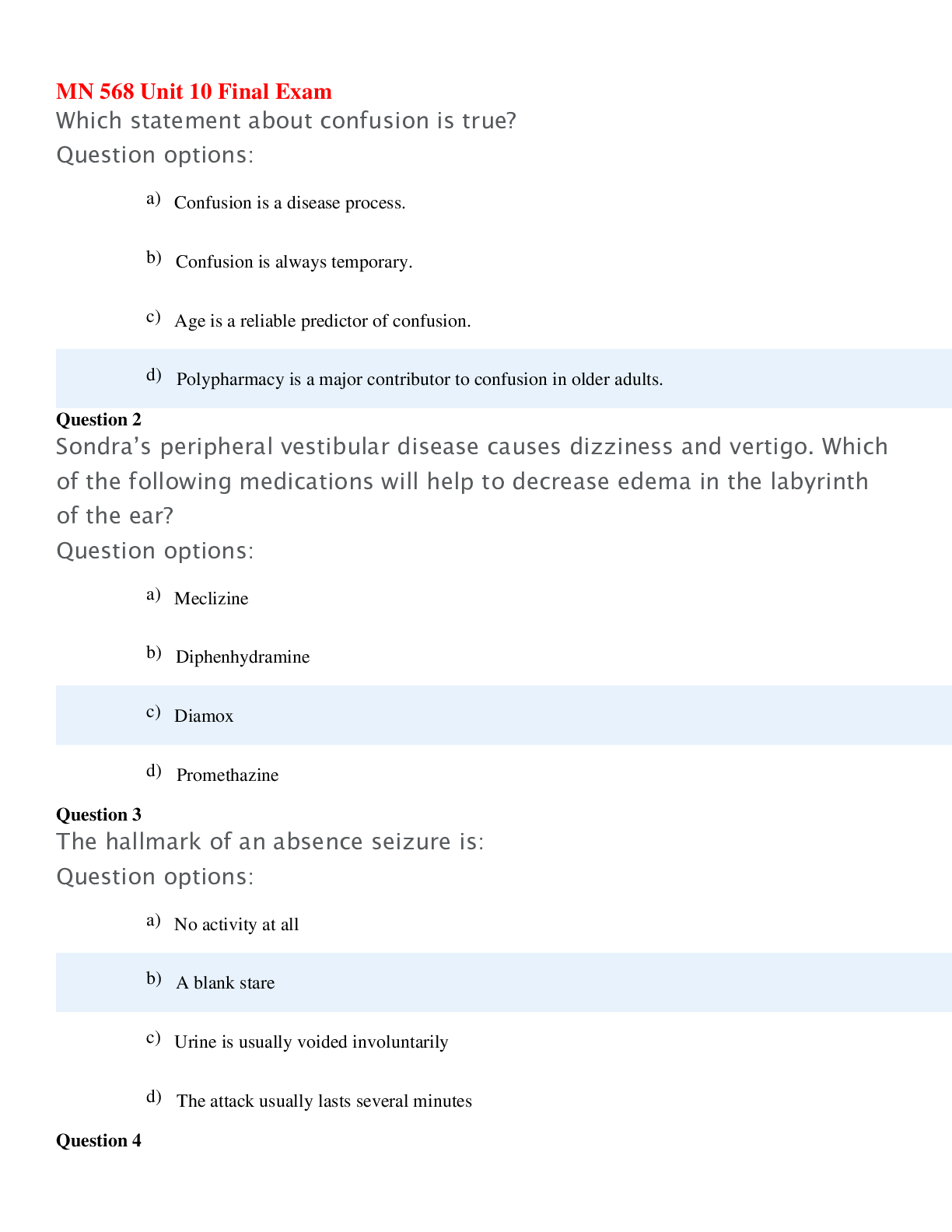
MN 568 Unit 2,4,6&10 Exams with Answers
MN 568 Unit 2,4,6&10 Exams with Answers
By YourTutor 3 years ago
$45.5
4
Reviews( 0 )
Document information
Connected school, study & course
About the document
Uploaded On
Feb 10, 2021
Number of pages
19
Written in
Additional information
This document has been written for:
Uploaded
Feb 10, 2021
Downloads
0
Views
44

